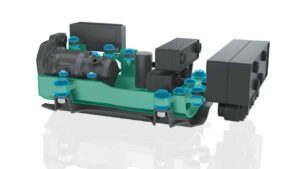Vibracoustic presents advanced NVH solution for thermal management systems in electric vehicles
Weinheim, Germany – Vibracoustic has designed, developed, and tested an innovative Thermal Management Decoupling System that supports and isolates the co-located thermal technologies commonly used in next-generation battery electric vehicles. Addressing a crucial challenge in the electric vehicle industry, the system optimizes the bundling of thermal components such as Heating, Ventilation, and Air Conditioning (HVAC) to save space, increase efficiency, and streamline assembly. This all-in architecture can be easily carried over in other vehicles without additional engineering. The thermal management system has proven its performance and reliability through extensive testing and benchmarking and is serial production ready.
As automotive Original Equipment Manufacturers (OEMs) continue to expand and improve their Battery Electric Vehicle (BEV) offerings, the transition to electrification has moved from initiation to optimization; the engineering focus has shifted from implementing new technologies to the seeking of incremental gains in performance, comfort, and refinement. This effort centers on powertrain and battery systems, but also includes critical thermal management systems.
To date, the packaging of these thermal systems in BEVs has proven challenging for OEMs looking to maximize packaging space in competitive utility vehicle segments. By co-locating or ‘bundling’ thermal systems, rather than separating them throughout the vehicle, OEMs and Tier 1 suppliers can save space while also simplifying routing complexity and hose and cable lengths. This reduces pressure losses between thermal components and improves system performance and efficiency. It also results in much easier, streamlined assembly and service access.
Vibracoustic’s Thermal Management Decoupling System has been adopted by leading international OEMs’ for next-generation large battery-electric vehicles such as SUVs, pick-ups, and vans. In these, the bundled thermal module consists of an air conditioning compressor, accumulator, pumps, and heat exchanger, among other components. These are mounted directly to the vehicle chassis and connected by hoses and cables.
With countless different resulting excitations, noises, and vibrations, isolating the consolidated systems required a whole-vehicle approach to NVH design and mitigation. Prior to Vibracoustic’s involvement, early design iterations proved to be too stiff and heavy, resulting in weight, cost, and packaging penalties. Vibracoustic’s engineers were able to rethink the design and come up with an innovative solution that took into account a number of considerations. These included the effect of attachment points, cables, and hoses on the stiffness and damping of the entire system, as well as all the excitations and interactions from the bundled systems.
Vibracoustic has collaborated with OEMs and Tier 1 suppliers to develop optimized solutions that would isolate this complex system from the vehicle chassis. The dedicated bracket designs are developed to mount the combined systems in the various vehicle platforms. These strong and lightweight die-cast aluminum brackets were fitted with custom rubber bushings to ensure optimum isolation overall.
Dr. Jörg Böcking, CTO at Vibracoustic, commented: “This project was an important opportunity for us to elevate NVH management in next generation battery electric vehicles. Co-locating thermal systems offers a number of benefits to OEMs, but it also creates substantial new challenges. As a global leader in NVH solutions, our team developed a bracket and mounting system that effectively cradles and isolates the consolidated systems, improving vehicle refinement. This project demonstrated our ability to apply comprehensive NVH expertise at every point in the supply chain, helping our partners overcome complex challenges at the forefront of sustainable mobility.”

